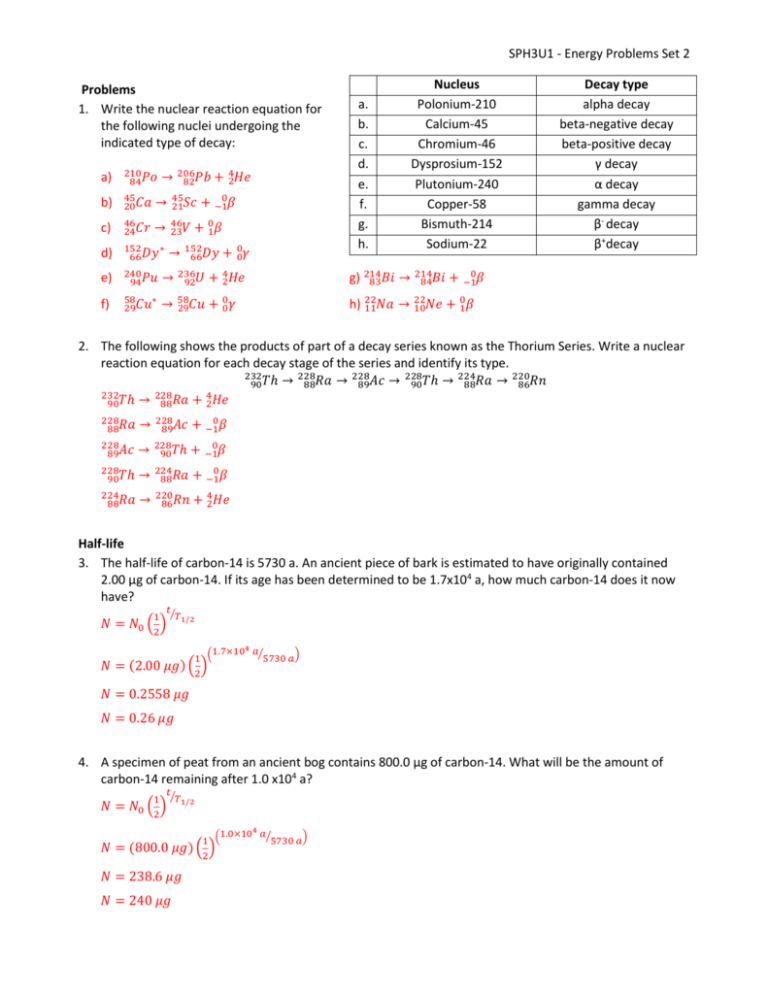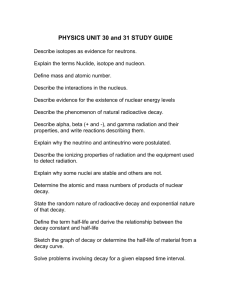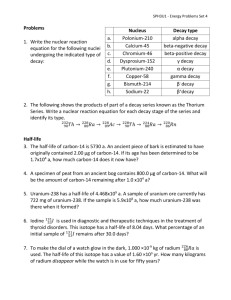Atomic Physics Problems Set Solutions
advertisement

SPH3U1 - Energy Problems Set 2 Problems 1. Write the nuclear reaction equation for the following nuclei undergoing the indicated type of decay: a) 210 84𝑃𝑜 b) 45 20𝐶𝑎 → 45 21𝑆𝑐 c) 46 24𝐶𝑟 → 46 23𝑉 d) 152 ∗ 66𝐷𝑦 e) 240 94𝑃𝑢 → 236 92𝑈 + 42𝐻𝑒 g) 214 83𝐵𝑖 → 214 84𝐵𝑖 f) 58 ∗ 29𝐶𝑢 → 58 29𝐶𝑢 + 00𝛾 h) 22 11𝑁𝑎 → 22 10𝑁𝑒 → 206 82𝑃𝑏 → + 42𝐻𝑒 a. b. c. d. e. f. g. h. Nucleus Polonium-210 Calcium-45 Chromium-46 Dysprosium-152 Plutonium-240 Copper-58 Bismuth-214 Sodium-22 + −10𝛽 + 01𝛽 152 66𝐷𝑦 + 00𝛾 Decay type alpha decay beta-negative decay beta-positive decay γ decay α decay gamma decay β- decay β+decay + −10𝛽 + 01𝛽 2. The following shows the products of part of a decay series known as the Thorium Series. Write a nuclear reaction equation for each decay stage of the series and identify its type. 232 228 228 228 224 220 90𝑇ℎ → 88𝑅𝑎 → 89𝐴𝑐 → 90𝑇ℎ → 88𝑅𝑎 → 86𝑅𝑛 232 228 4 90𝑇ℎ → 88𝑅𝑎 + 2𝐻𝑒 228 88𝑅𝑎 → 228 89𝐴𝑐 + −10𝛽 228 89𝐴𝑐 → 228 90𝑇ℎ + −10𝛽 228 90𝑇ℎ → 224 88𝑅𝑎 + −10𝛽 224 88𝑅𝑎 → 220 86𝑅𝑛 + 42𝐻𝑒 Half-life 3. The half-life of carbon-14 is 5730 a. An ancient piece of bark is estimated to have originally contained 2.00 µg of carbon-14. If its age has been determined to be 1.7x104 a, how much carbon-14 does it now have? 1 𝑡⁄ 𝑇1/2 𝑁 = 𝑁0 (2) 𝑁= 1.7×104 𝑎⁄ 1 ( 5730 𝑎) (2.00 𝜇𝑔) ( ) 2 𝑁 = 0.2558 𝜇𝑔 𝑁 = 0.26 𝜇𝑔 4. A specimen of peat from an ancient bog contains 800.0 µg of carbon-14. What will be the amount of carbon-14 remaining after 1.0 x104 a? 1 𝑡⁄ 𝑇1/2 𝑁 = 𝑁0 (2) 1.0×104 𝑎⁄ 1 ( 5730 𝑎) 2 𝑁 = (800.0 𝜇𝑔) ( ) 𝑁 = 238.6 𝜇𝑔 𝑁 = 240 𝜇𝑔 SPH3U1 - Energy Problems Set 5. Uranium-238 has a half-life of 4.468x109 a. A sample of uranium ore currently has 722 mg of uranium238. If the sample is 5.9x108 a, how much uranium-238 was there when it formed? 1 𝑡⁄ 𝑇1/2 𝑁 = 𝑁0 (2) 𝑁0 = 𝑁0 = 𝑁0 = 791.20 𝑚𝑔 𝑁 𝑁0 = 790 𝑚𝑔 𝑡 1 ⁄𝑇 ( ) 1/2 2 722 𝑚𝑔 5.9×108 𝑎⁄ ) 1 ( 4.468×109 𝑎 ( ) 2 6. Iodine 131 53𝐼 is used in diagnostic and therapeutic techniques in the treatment of thyroid disorders. This isotope has a half-life of 8.04 days. What percentage of an initial sample of 131 53𝐼 remains after 30.0 days? 1 𝑡⁄ 𝑇1/2 𝑁 𝑁0 𝑁 = 𝑁0 (2) 𝑁 𝑁0 𝑁 𝑁0 1 𝑡⁄ 𝑇1/2 = (2) = 1 ( (2) = 0.07529 % 𝑟𝑒𝑚𝑎𝑖𝑛𝑖𝑛𝑔 = 7.529 % = 7.53 % 30.0 𝑑𝑎𝑦𝑠 ⁄8.04 𝑑𝑎𝑦𝑠) 7. To make the dial of a watch glow in the dark, 1.000 ×10-9 kg of radium 226 88𝑅𝑎 is used. The half-life of this isotope has a value of 1.60 ×103 yr. How many kilograms of radium disappear while the watch is in use for fifty years? 1 2 𝑡⁄ 𝑇1/2 𝑁 = 𝑁0 ( ) 50 𝑎⁄ ) 1 ( 1.60×103 𝑎 𝑁 = (1.000 × 10−9 𝑘𝑔) (2) 𝑁 = 9.7857 × 10−10 𝑘𝑔 𝑅𝑎𝑑𝑖𝑠𝑎𝑝𝑝𝑒𝑎𝑟𝑒𝑑 = 1.000 × 10−9 𝑘𝑔 − 9.7857 × 10−10 𝑘𝑔 𝑅𝑎𝑑𝑖𝑠𝑎𝑝𝑝𝑒𝑎𝑟𝑒𝑑 = 2.14 × 10−11 𝑘𝑔 8. The shroud of Turin is a religious artefact known since the Middle Ages. In 1988 its age was measured using the radiocarbon dating technique, which revealed that the shroud could not have been made before 1200 AD. Of the 146𝐶 nuclei that were present in the living matter from which the shroud was made, what percentage remained in 1988? 1 𝑡⁄ 𝑇1/2 𝑁 = 𝑁0 (2) 1 𝑡⁄ 𝑇1/2 𝑁 𝑁0 = (2) 𝑁 𝑁0 = (2) 𝑁 𝑁0 = 0.9080 1988 𝑎−1200 𝑎⁄ 1 ( 5730 𝑎) % 𝑟𝑒𝑚𝑎𝑖𝑛𝑖𝑛𝑔 = 90.80 % = 91 % SPH3U1 - Energy Problems Set Nuclear Fission 9. During a nuclear reaction, an unknown particle is absorbed by a copper 63 29𝐶𝑢 nucleus, and the reaction products are 62 𝐶𝑢 , a neutron, and a proton. Determine the unknown particle and the nucleus 29 63 temporarily formed when the copper 29𝐶𝑢 nucleus absorbs the unknown particle. 63 29𝐶𝑢 ?? + ?? ??? ? → ??? ? → 62 29𝐶𝑢 63 29𝐶𝑢 + 11𝑝+ → → 64 30𝑍𝑛 + 10𝑛 + 11𝑝+ 62 29𝐶𝑢 + 10𝑛 + 11𝑝+ 10. A neutron causes 232 90𝑇ℎ to fission according to the reaction 232 1 𝐴 0 90𝑇ℎ + 0𝑛 → 𝑍𝑋 + 0𝛾 a. Identify the unknown nucleus , giving its atomic mass number A, its atomic number Z, and the symbol X for the element. 232 1 233 0 90𝑇ℎ + 0𝑛 → 90𝑇ℎ + 0𝛾 b. Nucleus X then undergoes β- decay, and its daughter does too. Identify the final nucleus, giving its atomic mass number, atomic number, and name. 233 233 0 90𝑇ℎ → 91𝑃𝑎 + −1𝛽 233 91𝑃𝑎 → 233 92𝑈 + −10𝛽 11. A small sample of coal, when completely converted to energy, releases 4.5 × 1014 J of energy. Determine the original mass of coal, assuming the final mass is zero. 𝐸 = ∆𝑚𝑐 2 𝑚 = 5.0068 × 10−3 𝑘𝑔 𝐸 𝑚2 − 𝑚1 = 𝑐 2 𝑚 = 5.0 𝑔 4.5×1014 𝑚 = (2.998×108 𝐽 𝑚/𝑠)2 12. Calculate the mass defect, in kilograms, and the energy released, in joules, of the following nuclear reaction: 140 235 1 93 1 92𝑈 + 0𝑛 → 55𝐶𝑠 + 37𝑅𝑏 + 3 0𝑛 93 = 235.044 𝑢, 10𝑛 = 1.009 𝑢, 140 55𝐶𝑠 = 139.909 𝑢, 37𝑅𝑏 = 92.922 𝑢 ∆𝑚 = 𝑚𝑝𝑟𝑜𝑑𝑢𝑐𝑡𝑠 − 𝑚𝑟𝑒𝑎𝑐𝑡𝑎𝑛𝑡𝑠 ∆𝑚 = 𝑚𝐶𝑠 + 𝑚𝑅𝑏 + 3𝑚𝑛 − (𝑚𝑈 + 𝑚𝑛 ) ∆𝑚 = 139.909 𝑢 + 92.922 𝑢 + 3(1.009 𝑢) − (235.044 𝑢 + 1.009 𝑢) ∆𝑚 = −0.195 𝑢 ∆𝑚 = 0.195 𝑢 𝑙𝑒𝑠𝑠 235 92𝑈 𝐸 𝐸 𝐸 𝐸 = ∆𝑚𝑐 2 = (0.195 𝑢)(1.660538782 × 10−27 𝑘𝑔/𝑢)(2.998 × 108 𝑚/𝑠)2 = 2.91036 × 10−11 𝐽 = 2.91 × 10−11 𝐽 SPH3U1 - Energy Problems Set 13. How much energy, in MeV, is released by the following fission reaction? 235 92𝑈 235 92𝑈 = 235.044 𝑢, 10𝑛 = 1.009 𝑢, 96 38𝑆𝑟 + 10𝑛 → 94 38𝑆𝑟 1 + 140 54𝑋𝑒 + 2 0𝑛 = 93.915 𝑢, 140 54𝑋𝑒 = 139.922 𝑢 ∆𝑚 = 𝑚𝑝𝑟𝑜𝑑𝑢𝑐𝑡𝑠 − 𝑚𝑟𝑒𝑎𝑐𝑡𝑎𝑛𝑡𝑠 ∆𝑚 = 𝑚𝑆𝑟 + 𝑚𝑋𝑒 + 2𝑚𝑛 − (𝑚𝑈 + 𝑚𝑛 ) ∆𝑚 = 93.915 𝑢 + 139.922 𝑢 + 2(1.009 𝑢) − (235.044 𝑢 + 1.009 𝑢) ∆𝑚 = −0.198 𝑢 ∆𝑚 = 0.198 𝑢 𝑙𝑒𝑠𝑠 𝐸 𝐸 𝐸 𝐸 = ∆𝑚𝑐 2 = (0.198 𝑢)(930 𝑀𝑒𝑉/𝑢) = 184.14 𝑀𝑒𝑉 = 184 𝑀𝑒𝑉 2 14. The energy released during each 235 92𝑈 fission is 2.0 × 10 MeV. How many kilograms of coal must be 7 burned to produce the same energy as 1.0 kg of 235 92𝑈 if 3.0 × 10 J of energy is released when 1.0 kg of 24 coal is burned? (n.b. 2.6 x10 U nuclei are found in a 1 kg sample of uranium) 𝑛𝑈 𝑛𝑢𝑐𝑙𝑒𝑖 𝑛𝑈 𝑛𝑢𝑐𝑙𝑒𝑖 𝑛𝑈 𝑛𝑢𝑐𝑙𝑒𝑖 𝑛𝑈 𝑛𝑢𝑐𝑙𝑒𝑖 = (𝑚𝑎𝑠𝑠 𝑜𝑓 𝑈235 ) ÷ (𝑚𝑜𝑙𝑎𝑟 𝑚𝑎𝑠𝑠 𝑜𝑓 𝑈235 ) × (6.02 × 1023 𝑎𝑡𝑜𝑚𝑠/𝑚𝑜𝑙) = (1.0 𝑘𝑔) ÷ (0.235 𝑘𝑔/𝑚𝑜𝑙) × (6.02 × 1023 𝑎𝑡𝑜𝑚𝑠/𝑚𝑜𝑙) = 2.56170 × 1024 = 2.6 × 1024 𝐸 = (𝑛𝑟𝑒𝑎𝑐𝑡𝑖𝑜𝑛𝑠 )(𝐸𝑛𝑒𝑟𝑔𝑦/𝑟𝑒𝑎𝑐𝑡𝑖𝑜𝑛) 𝐸 = (2.6 × 1024 )(2.0 × 102 𝑀𝑒𝑉)(1.602 × 10−13 𝐽/𝑀𝑒𝑉) 𝐸 = 8.3304 × 1013 𝐽 𝐸𝑛𝑒𝑟𝑔𝑦 𝑟𝑒𝑞𝑢𝑖𝑟𝑒𝑑 𝑢𝑛𝑘𝑛𝑜𝑤𝑛 𝑚𝑎𝑠𝑠𝑐𝑜𝑎𝑙 𝐸𝑛𝑒𝑟𝑔𝑦 = 1.0 𝑘𝑔 𝑢𝑛𝑘𝑛𝑜𝑤𝑛 𝑚𝑎𝑠𝑠𝑐𝑜𝑎𝑙 𝑢𝑛𝑘𝑛𝑜𝑤𝑛 𝑚𝑎𝑠𝑠𝑐𝑜𝑎𝑙 𝑢𝑛𝑘𝑛𝑜𝑤𝑛 𝑚𝑎𝑠𝑠𝑐𝑜𝑎𝑙 𝑢𝑛𝑘𝑛𝑜𝑤𝑛 𝑚𝑎𝑠𝑠𝑐𝑜𝑎𝑙 𝑐𝑜𝑎𝑙 = (𝐸𝑛𝑒𝑟𝑔𝑦 𝑟𝑒𝑞𝑢𝑖𝑟𝑒𝑑)/(𝐸𝑛𝑒𝑟𝑔𝑦/𝑘𝑔) = (8.3304 × 1013 𝐽)/(3.0 × 107 𝐽/𝑘𝑔) = 2776800 𝑘𝑔 = 2.8 × 106 𝑘𝑔 SPH3U1 - Energy Problems Set Nuclear Fusion 15. One reaction to produce carbon in stars is as follows: 4 4 4 12 2𝐻𝑒 + 2𝐻𝑒 + 2𝐻𝑒 → 6𝐶 Calculate the mass defect, in atomic mass units, and energy released, in electronvolts, of this reaction. 12 ( 42𝐻𝑒 m=4.002603 u, 6𝐶 m = 12.00000 u) ∆𝑚 = 𝑚𝑝𝑟𝑜𝑑𝑢𝑐𝑡𝑠 − 𝑚𝑟𝑒𝑎𝑐𝑡𝑎𝑛𝑡𝑠 ∆𝑚 = 𝑚𝐶 − 3(𝑚𝐻𝑒 ) ∆𝑚 = 12.00000 𝑢 − 3(4.002603 𝑢) ∆𝑚 = −7.809 × 10−3 𝑢 ∆𝑚 = 7.8 × 10−3 𝑢 𝑙𝑒𝑠𝑠 𝐸 𝐸 𝐸 𝐸 = ∆𝑚𝑐 2 = (7.8 × 10−3 𝑢 )(930 𝑀𝑒𝑉/𝑢) = 7.254 × 106 𝑒𝑉 = 7.3 × 106 𝑒𝑉 16. Consider the induced nuclear reaction 21𝐻 + 147𝑁 → 126𝐶 + 42𝐻𝑒 . The atomic masses are 21𝐻 (2.014 102 u), 147𝑁 (14.003 074 u), 126𝐶 (12.000 000 u), and 42𝐻𝑒 (4.002 603 u). Determine the energy released, in joules, when the 126𝐶 and 42𝐻𝑒 nuclei are formed in this way. ∆𝑚 = 𝑚𝑝𝑟𝑜𝑑𝑢𝑐𝑡𝑠 − 𝑚𝑟𝑒𝑎𝑐𝑡𝑎𝑛𝑡𝑠 ∆𝑚 = 𝑚𝐶 + 𝑚𝐻𝑒 − (𝑚𝑁 + 𝑚𝐻 ) ∆𝑚 = 12.00000 𝑢 + 4.002 603 𝑢 − (14.003 074 𝑢 + 2.014 102 𝑢) ∆𝑚 = −0.014573 𝑢 𝐸 𝐸 𝐸 𝐸 = ∆𝑚𝑐 2 = (0.014573 𝑢 )(930 𝑀𝑒𝑉/𝑢)(1.602 × 10−13 𝐽/𝑀𝑒𝑉) = 2.17117 × 10−12 𝐽 = 2.2 × 10−12 𝐽 17. Two deuterium atoms ( 21𝐻= 2.014102 u) react to produce tritium ( 31𝐻= 3.016050 u) and hydrogen ( 11𝐻= 1.007825 u) according to the reaction: 2 2 3 1 1𝐻 + 1𝐻 → 1 𝐻 + 1𝐻 What is the energy released by this deuterium-deuterium reaction? ∆𝑚 = 𝑚𝑝𝑟𝑜𝑑𝑢𝑐𝑡𝑠 − 𝑚𝑟𝑒𝑎𝑐𝑡𝑎𝑛𝑡𝑠 ∆𝑚 = 𝑚𝐻−3 + 𝑚𝐻 − 2(𝑚𝐻−2 ) ∆𝑚 = 3.016050 𝑢 + 1.007825 𝑢 − 2(2.014102 𝑢) ∆𝑚 = −4.329 × 10−3 𝑢 𝐸 𝐸 𝐸 𝐸 𝐸 = ∆𝑚𝑐 2 = (4.329 × 10−3 𝑢 )(930 𝑀𝑒𝑉/𝑢) = 4.02597 𝑀𝑒𝑉 = 4.0 𝑀𝑒𝑉 = 6.4 × 10−3 𝐽 SPH3U1 - Energy Problems Set 18. One proposed fusion reaction combines lithium 63𝐿𝑖 (6.015 u) with deuterium 21𝐻 (2.014 u) to give helium 4 2𝐻𝑒 (4.003 u): 2 1𝐻 + 63𝐿𝑖 → 2 42𝐻𝑒 a) How many of the above reactions would need to occur to supply the energy needs of one household for a year (estimated to be 3.8 × 1010 J)? ∆𝑚 = 𝑚𝑝𝑟𝑜𝑑𝑢𝑐𝑡𝑠 − 𝑚𝑟𝑒𝑎𝑐𝑡𝑎𝑛𝑡𝑠 ∆𝑚 = 2𝑚𝐻𝑒 − (𝑚𝐿𝑖 + 𝑚𝐻−2 ) ∆𝑚 = 2(4.003 𝑢) − (6.015 𝑢 + 2.014 𝑢) ∆𝑚 = −0.023 𝑢 𝐸 = ∆𝑚𝑐 2 𝐸 = (0.023 𝑢)(930 𝑀𝑒𝑉/𝑢)(1.602 × 10−13 𝐽/𝑀𝑒𝑉) 𝐸 = 3.426678 × 10−12 𝐽 𝑛𝑟𝑒𝑎𝑐𝑡𝑖𝑜𝑛𝑠 = 𝑛𝑟𝑒𝑎𝑐𝑡𝑖𝑜𝑛𝑠 = 𝑡𝑜𝑡𝑎𝑙 𝑒𝑛𝑒𝑟𝑔𝑦 𝑒𝑛𝑒𝑟𝑔𝑦 𝑝𝑒𝑟 𝑟𝑒𝑎𝑐𝑡𝑖𝑜𝑛 3.8×1010 𝐽 3.426678×10−12 𝐽/𝑟𝑒𝑎𝑐𝑡𝑖𝑜𝑛 22 𝑛𝑟𝑒𝑎𝑐𝑡𝑖𝑜𝑛𝑠 = 1.10895 × 10 𝑟𝑒𝑎𝑐𝑡𝑖𝑜𝑛𝑠 𝑛𝑟𝑒𝑎𝑐𝑡𝑖𝑜𝑛𝑠 = 1.1 × 1022 𝑟𝑒𝑎𝑐𝑡𝑖𝑜𝑛𝑠 b) How many grams of lithium would be needed if there are 8.673x1025 Li nuclei in 1 kg of a lithium sample? 𝑥 𝑘𝑔 1 𝑘𝑔 = 1.1×1022 𝑛𝑢𝑐𝑙𝑒𝑖 8.673×1025 𝑛𝑢𝑐𝑙𝑒𝑖 (1 𝑘𝑔)(1.1×1022 𝑛𝑢𝑐𝑙𝑒𝑖) 𝑥= 8.673×1025 𝑛𝑢𝑐𝑙𝑒𝑖 −4 𝑥 = 1.268304 × 10 𝑚𝑎𝑠𝑠𝐿𝑖 = 0.13 𝑔 𝑘𝑔 19. The following shows the carbon-nitrogen-oxygen (CNO) cycle that occurs inside stars. Write a nuclear reaction equation for each stage in the cycle and identify its type. 12 13 13 14 15 15 12 4 6𝐶 → 7𝑁 → 6𝐶 → 7𝑁 → 8𝑂 → 7𝑁 → 6𝐶 + 2𝐻𝑒 12 1 13 nuclear fusion ( + gamma particle released) 6𝐶 + 1𝐻 → 7𝑁 13 7𝑁 → 13 6𝐶 13 6𝐶 + 11𝐻 → 14 7𝑁 nuclear fusion ( + gamma particle released) 14 7𝑁 + 11𝐻 → 15 8𝑂 nuclear fusion ( + gamma particle released) 15 8𝑂 → 15 7𝑁 + 11𝐻 → 15 7𝑁 + 01𝛽 beta+ decay + + 01𝛽 12 6𝐶 + 42𝐻𝑒 beta+ decay nuclear fusion ( + alpha particle released) SPH3U1 - Energy Problems Set Conceptual Questions 1. To which of the following objects, each about 1000 yr old, can the radiocarbon dating technique not be applied: a wooden box, a gold statue, and some plant seeds? Explain. Wooden box and plant seeds. Both of these objects contain carbon, so can be used for radiocarbon dating, whereas a gold statue does not. 2. Some preserved seed were found and their age, through the technique of carbon dating, was determined to be 5000 years old. However, new evidence suggests that the amount of carbon in the air at that time is higher than previously thought. Are the seeds older or younger than 5000 years? Explain. Older. If there were more C-14 in the beginning but that same amount currently, this would mean that the seeds have lost more C-14 than previously thought. In order to do so, they must have existed for a longer amount of time, so are older than 5000 years. 3. Compare and contrast nuclear fission and fusion. How are they alike? How are they different? Fission and fusion are similar because both processes result in more stable nuclei. They both achieve this by releasing energy which can be used as a power source. They differ in that a large nucleus breaks into smaller fragments when undergoing fission and smaller nuclei combine to make a larger one when undergoing fusion. Fusion also, in general, releases more energy per reaction than fission. 4. Why are neutrons such good projectiles for producing nuclear reactions? Neutrons are good projectiles for producing nuclear reactions because they are neutral and they are massive. If you want a particle to hit the nucleus with a lot of energy, a more massive particle is the better choice. A light electron would not be as effective. Using a positively charged projectile like an alpha or a proton means that the projectile will have to overcome the large electrical repulsion from the positively charged nucleus. Neutrons can penetrate directly to the nucleus and cause nuclear reactions. 5. Explain why nuclear fusion is much more difficult to obtain than nuclear fission To fuse two nuclei together they must have enough energy (travelling fast enough) to overcome their mutual repulsion. To break apart a large nucleus, a neutron with relatively low energy can be used to strike and destabilize it as the neutron has no charge and is not repelled. 6. Why is nuclear fusion more desirable than nuclear fission for power generation? Explain. Fusion releases more energy per reaction than does fission, and so it is more efficient. Also, the products of fusion are stable nuclei, and have minimal environmental impact, whereas fission products are radioactive (and can be for thousands of years) and so storing them pose serious environmental (and technological) challenges. 7. The energy from nuclear fission appears in the form of thermal energy – but the thermal energy of what? Explain. The thermal energy from nuclear fission appears in the kinetic energy of the fission products (daughter nuclei and neutrons). In other words, the fission products are moving very fast (especially the neutrons).








